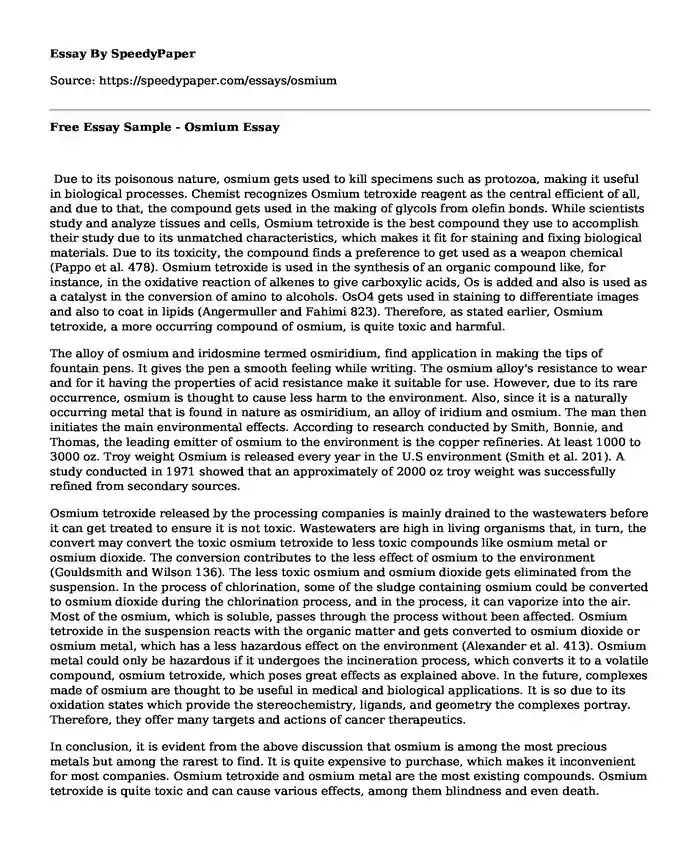Due to its poisonous nature, osmium gets used to kill specimens such as protozoa, making it useful in biological processes. Chemist recognizes Osmium tetroxide reagent as the central efficient of all, and due to that, the compound gets used in the making of glycols from olefin bonds. While scientists study and analyze tissues and cells, Osmium tetroxide is the best compound they use to accomplish their study due to its unmatched characteristics, which makes it fit for staining and fixing biological materials. Due to its toxicity, the compound finds a preference to get used as a weapon chemical (Pappo et al. 478). Osmium tetroxide is used in the synthesis of an organic compound like, for instance, in the oxidative reaction of alkenes to give carboxylic acids, Os is added and also is used as a catalyst in the conversion of amino to alcohols. OsO4 gets used in staining to differentiate images and also to coat in lipids (Angermuller and Fahimi 823). Therefore, as stated earlier, Osmium tetroxide, a more occurring compound of osmium, is quite toxic and harmful.
The alloy of osmium and iridosmine termed osmiridium, find application in making the tips of fountain pens. It gives the pen a smooth feeling while writing. The osmium alloy's resistance to wear and for it having the properties of acid resistance make it suitable for use. However, due to its rare occurrence, osmium is thought to cause less harm to the environment. Also, since it is a naturally occurring metal that is found in nature as osmiridium, an alloy of iridium and osmium. The man then initiates the main environmental effects. According to research conducted by Smith, Bonnie, and Thomas, the leading emitter of osmium to the environment is the copper refineries. At least 1000 to 3000 oz. Troy weight Osmium is released every year in the U.S environment (Smith et al. 201). A study conducted in 1971 showed that an approximately of 2000 oz troy weight was successfully refined from secondary sources.
Osmium tetroxide released by the processing companies is mainly drained to the wastewaters before it can get treated to ensure it is not toxic. Wastewaters are high in living organisms that, in turn, the convert may convert the toxic osmium tetroxide to less toxic compounds like osmium metal or osmium dioxide. The conversion contributes to the less effect of osmium to the environment (Gouldsmith and Wilson 136). The less toxic osmium and osmium dioxide gets eliminated from the suspension. In the process of chlorination, some of the sludge containing osmium could be converted to osmium dioxide during the chlorination process, and in the process, it can vaporize into the air. Most of the osmium, which is soluble, passes through the process without been affected. Osmium tetroxide in the suspension reacts with the organic matter and gets converted to osmium dioxide or osmium metal, which has a less hazardous effect on the environment (Alexander et al. 413). Osmium metal could only be hazardous if it undergoes the incineration process, which converts it to a volatile compound, osmium tetroxide, which poses great effects as explained above. In the future, complexes made of osmium are thought to be useful in medical and biological applications. It is so due to its oxidation states which provide the stereochemistry, ligands, and geometry the complexes portray. Therefore, they offer many targets and actions of cancer therapeutics.
In conclusion, it is evident from the above discussion that osmium is among the most precious metals but among the rarest to find. It is quite expensive to purchase, which makes it inconvenient for most companies. Osmium tetroxide and osmium metal are the most existing compounds. Osmium tetroxide is quite toxic and can cause various effects, among them blindness and even death.
Works Cited
Alexander, Illis, Brandt Bernardus Jacobus, and Manson Alan. "Process for recovering osmium." U.S. Patent No. 3,413,114. 26 Nov. 1968. Retrieved from: patents.google.com/patent/US3413114A/en
Angermuller, Sabine, and H. Dariush Fahimi. "Imidazole-buffered osmium tetroxide: an excellent stain for visualization of lipids in transmission electron microscopy." The Histochemical Journal 14.5 (1982): 823-835. Retrieved from: link.springer.com/article/10.1007/BF01033631
Gouldsmith, A. F. S. and B. Wilson. "Extraction and refining of the platinum metals." Platinum Metals Review 7.4 (1963): 136-143. Retrieved from www.ingentaconnect.com/content/matthey/pmr/1963/00000007/00000004/art00009?crawler=true&mimetype=application/pdf
Gross, Richard M., Nriagu, Jerome O, and Ulrich, Nina." Thallium, platinum, and Antimony analysis." The journal of C & EN 43.3 (2019): 24-43. Retrieved from: acs.org/pitchACS
Grubbs, Robert H., Lynda K. Johnson, and Sonbinh T. Nguyen. "Ruthenium and osmium metal carbene complexes for olefin metathesis polymerization." U.S. Patent No. 5,312,940. 17 May 1994. Retrieved from: patentimages.storage.googleapis.com/68/7c/ef/820c69309c6618/US5312940.pdf
Mason, Robert J., Jean Nellenbogen, and John A. Clements. "Isolation of disaturated phosphatidylcholine with osmium tetroxide." Journal of lipid research 17.3 (1976): 281-284. Retrieved from: www.jlr.org/content/17/3/281.full.pdf
Pappo, R., et al. "Osmium tetroxide-catalyzed periodate oxidation of olefinic bonds." The Journal of Organic Chemistry 21.4 (1956): 478-479. Retrieved from: pubs.acs.org/doi/abs/10.1021/jo01110a606
Shott, Ian. "Celebrating 80 years of covering the Chemical Enterprise." The Journal of the Chemical & Engineering News 202.4 (2003): 872-4600. Retrieved from: pubsapp.acs.org/cen/80th/osmium.html?
Smith, Ivan C., Bonnie L. Carson, and Thomas L. Ferguson. "Osmium: an appraisal of environmental exposure." Environmental health perspectives 8 (1974): 201-213. Retrieved from: ehp.niehs.nih.gov/doi/pdf/10.1289/ehp.748201
Travis, Benjamin R., Radha S. Narayan, and Babak Borhan. "Osmium tetroxide-promoted catalytic oxidative cleavage of olefins: organometallic ozonolysis." Journal of the American Chemical Society 124.15 (2002): 3824-3825. Retrieved from: pubs.acs.org/doi/abs/10.1021/ja00532a050
Cite this page
Free Essay Sample - Osmium. (2023, Mar 15). Retrieved from https://speedypaper.net/essays/osmium
Request Removal
If you are the original author of this essay and no longer wish to have it published on the SpeedyPaper website, please click below to request its removal:
- Essay Sample: Introduction to the Effects of Technology on Manual Jobs
- Plants for Food - Free Essay from Our Database
- Free Essay About Transgender in the Contemporary American Society
- Education Essay Example - Application of Curriculum Phases
- Essay Example: Screening Recommendations for Heart Conditions
- Teaching Essay Sample: Reading Mini-Lessons
- Negative Effects of Technology on Interpersonal Communication, Essay Sample
Popular categories





